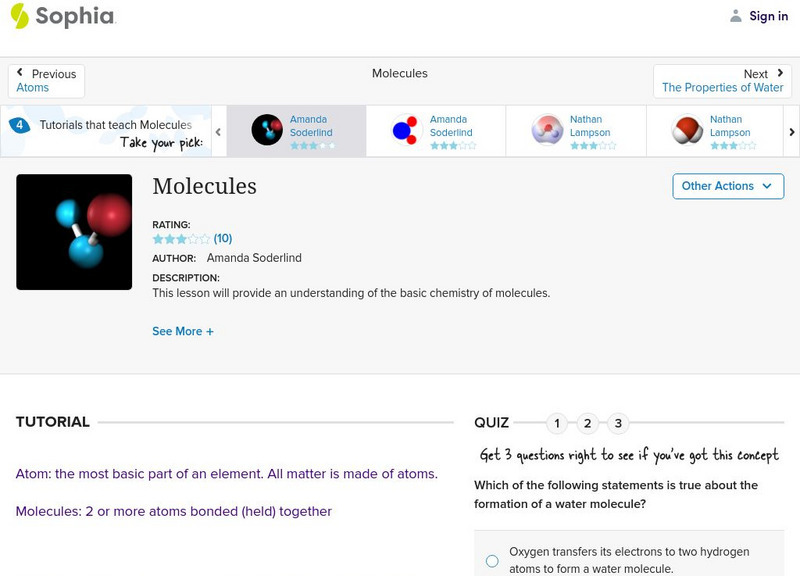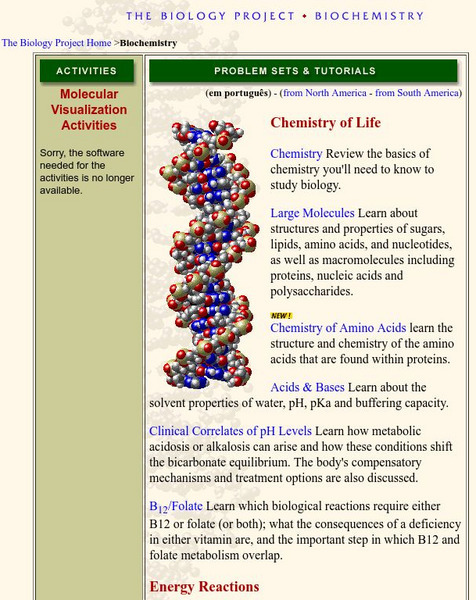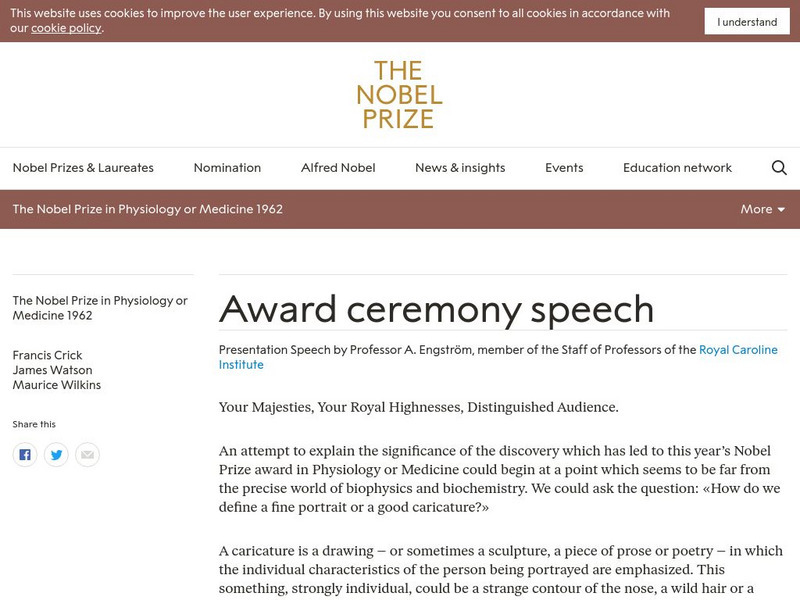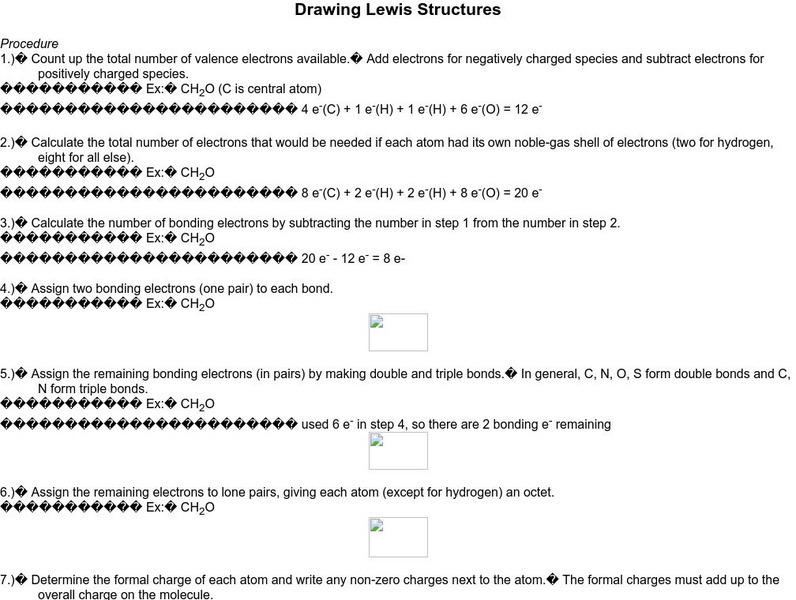Chiral Publishing
Chiral Publishing: An Introduction to Chemistry: Molecular Structures: Polysaccharides
View complex carbohydrates from every angle by manipulating starch and cellulose molecules. Also find links to information about other organic structures.
Florida State University
Florida State University: Molecular Expressions: Making Crystals
Students will work in groups to grow crystals in different conditions, and then make conclusions about how and why crystals form. A detailed procedure and materials list, follow-up questions, and a teacher's guide that contains extension...
State University of New York
State University of New York: Determining Molecular Polarity
The following module illustrates a method for determining if a molecule is polar or nonpolar.
Cosmo Learning
Cosmo Learning: General Chemistry
A collection of video lectures from a general chemistry course taught at the University of California, Berkeley. The course teaches periodic table, chemical bonds, molecular shape, phase changes, chemical reactions, stoichiometry,...
Famous Scientists
Famous Scientists: Francis Crick
Discover Francis Crick, British molecular biologist, physicist, and neuroscientist who jointly won a Nobel Prize for his discoveries concerning the molecular structure of nucleic acids.
Sophia Learning
Sophia: Molecules
An audio podcast accompanied by a diagram of a water molecule helps the learner understand molecular structure. [0:23]
Concord Consortium
Concord Consortium: Stem Resources: Ceramic Forces
Different ceramic materials have different mechanical properties and molecular structures, which affect how each responds to a force exerted on it. Try varying amounts of force on a ceramic beam (an ionic lattice) to see how it responds...
Other
My Science Box: Dna Models
Hands-on lesson in which learners play with puzzle pieces representing the DNA molecule to discover the molecular structure of DNA.
National Health Museum
Access Excellence: Dna Structure
Access Excellence provides an interesting graphic which shows the helical structure of DNA from the molecular to chromosomal scale.
University of Arizona
University of Arizona: Biochemistry
Problem sets, tutorials, and activities related to biochemistry.
Vision Learning
Visionlearning: Atomic Theory and Structure: The Mole: Its History and Use
An introduction to the mole, a unit of measurement that quantifies atoms and molecules.
Concord Consortium
Concord Consortium: Metal Forces
Explore what happens when a force is exerted on a metallic material. The molecular structure of the material affects how it responds to an applied force at the macroscopic level.
Nobel Media AB
The Nobel Prize: James Watson Biographical
Read about James Dewey Watson, the co-recipient of the 1962 Nobel Prize in Medicine for his work with Franice Crick on decoding the structure of DNA. This article includes information on both Watson's personal life and public career.
Nobel Media AB
The Nobel Prize: The Nobel Prize in Physiology or Medicine 1962 Award Ceremony
Here you can find the full text of the speech, by Professor A. Engstrom, presenting the 1962 Nobel Prize in Physiology or Medicine to Maurice Wilkins, James Watson, and Francis Crick for their discovery of DNA's structure. The speech...
Concord Consortium
Concord Consortium: Molecular Workbench: Self Assembling Lattice Structure
View this simulation to see how lattice structures are formed when particles of different shapes and charges form bonds.
University of California
Ucla: Drawing Lewis Structures
A step-by-step explanation on how to draw Lewis structures. An example problem is worked through to accompany the steps. There is also a list of the exceptions and a short explanation of resonance.
Concord Consortium
The Concord Consortium: Molecular Workbench: Crawler
Adjust variables to experiment with a worm like structure to see how the changes affect its movement.
Yale University
Yale University Center for Structural Biology
This site is an excellent resource on the research and graduate studies programs in the field of biophysics.
National Health Museum
Access Excellence: Making a Phylogenetic Tree Lesson Plan
Constructing phylogenetic trees may be a daunting task for learners, but this lesson plan is a simulation of what molecular biologists must do to determine relationships. This plan is for students who have a good grasp of DNA structure...
Khan Academy
Khan Academy: Molecular Genetics and Microbiology of Zaire Ebolavirus
Read this passage and study the graphics to complete a five-question quiz related to the Ebola virus life cycle.
Towson University
Towson University: Shapes of Molecules
This chemistry class printout details the main points of molecular geometry and explains bond hybridization and bond angles.
TED Talks
Ted: Ted Ed: The Invisible Motion of Still Objects
Ran Tivony describes how and why molecular movement occurs and investigates if it might ever stop. [4:44]
Davidson College
Davidson College: Network Solids: Crystalline Solids
Explains the differences between ionic, molecular, metallic, and network crystalline solids. Displays structures for diamond, graphite, fullerene, and silica, accompanied by questions about their chemical bonding. Electron density plots...
Chiral Publishing
Chiral Publishing: An Introduction to Chemistry: Resonance
This section from "An Introduction to Chemistry" describes how to draw resonance structures. A few examples are given. Also find links to 3-D molecular models of the examples.
Other popular searches
- Molecular Structure Lab
- Mineral Molecular Structure
- Building Molecular Structure
- Molecular Structure of Water
- Molecular Shape of Compounds
- Giant Molecular Structure
- Atomic and Molecular Structure
- Lewis Structure Molecular















